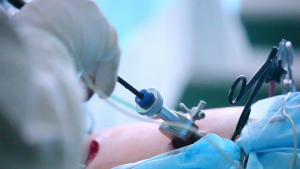INTRODUCTION
Laparoscopic surgery is a surgical technique in which short, narrow tubes ( trocars) are inserted into the abdomen through small ( less than one centimeter ) incisions . Through these trochars long narrow instruments to manipulate, cut and see tissue
ADVANTAGE
In patients terms, laparoscopic surgery has the advantages of avoiding large open wounds or incisions and thus of decreasing blood loss , pain and discomfort . Patients have fewer unwanted effects from analgesia because less analgesia is required .The fine instruments are less apt to cause tissue trauma and blood loss. Also it has better quality of life outcomes than open surgery for cholecystectomy, splenectomy and esophageal surgery. However open hernioplasty has at least as good if not better , health status outcomes than laparoscopic repair
DISADVANTAGES
It can take longer to perform than open surgery ( if not performed with right technique) . The longer time under anesthesia may increase the risk of complication. Sometimes complications do not appear right away but occurs few days to few weeks after surgery
SIDE EFFECTS
- Fever or chills
- Abdominal pain that becomes more intense over time
- Redness , swelling , bleeding or drainage at the incision sites
- continuous nausea or vomiting
- Persistent cough
- Shortness of breath
- Inability to urinate
- Lightheadness
HOW IS LAPAROSCOPY PERFORMED ?
It is usually done as an outpatient procedure. General anesthesia is given as intravenous line in one of your veins. In some cases local anesthesia is also used. During laparoscopy, the surgeon makes an incision below your belly button and then inserts a small tube called a cannula. The cannula is used to inflate your abdomen with carbon dioxide gas. This gas allows your doctor to see your abdominal organs more clearly. Once abdomen is inflated , the surgeon inserts the laparoscope through the incision. The camera attached to the laparoscope displays the images on a screen, allowing your organs to be viewed in real time. Generally you get from one to four incisions that are each between 1 and 2 centimeters in length. These incisions allow other instruments to be inserted . After the procedure is done , the instruments are removed. Your incisions are then closed with stitches or surgical staples
To get opinion from our network of hospitals visit www.mvtbooking.com or send email to query@gtsmeditour.com


Post a comment